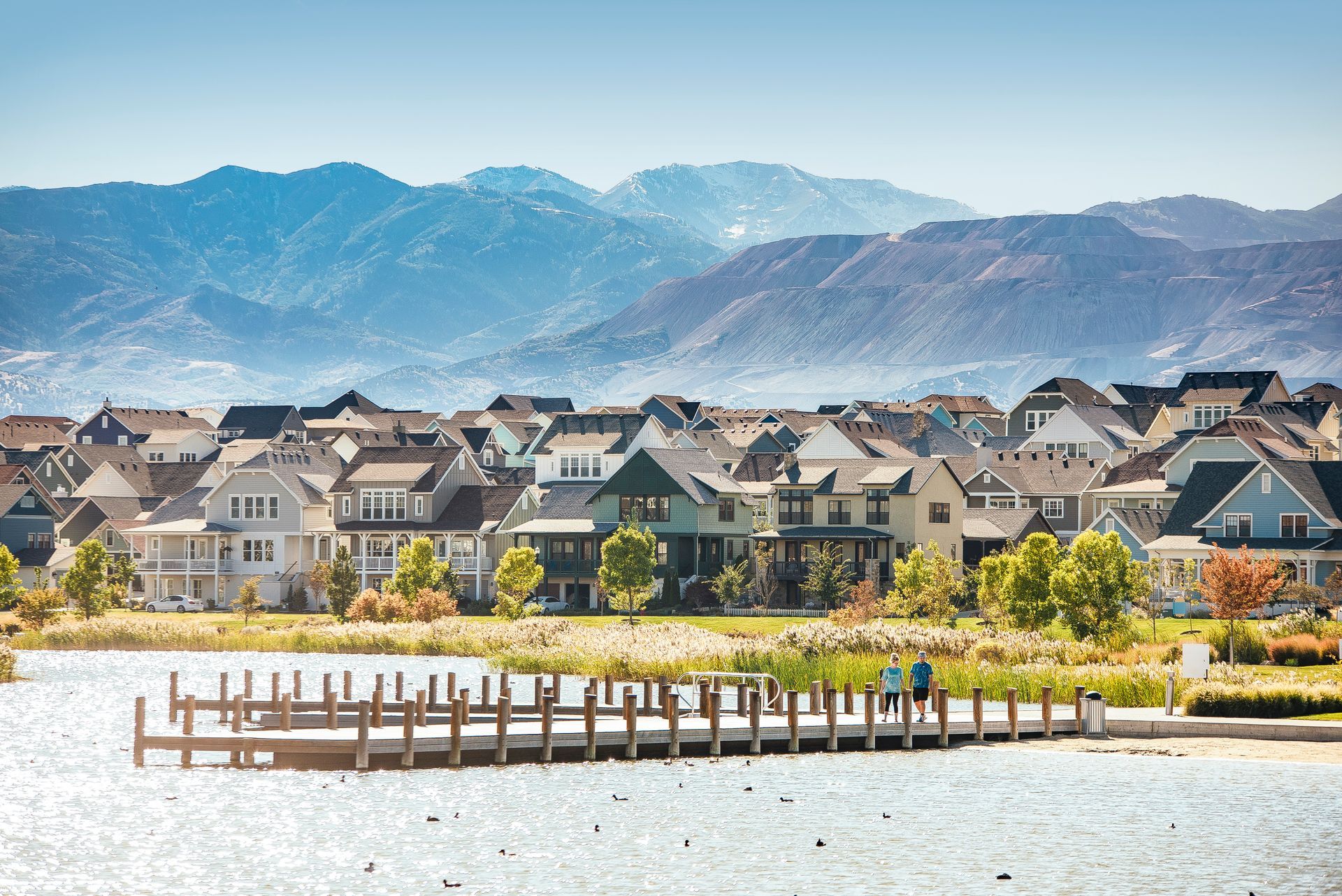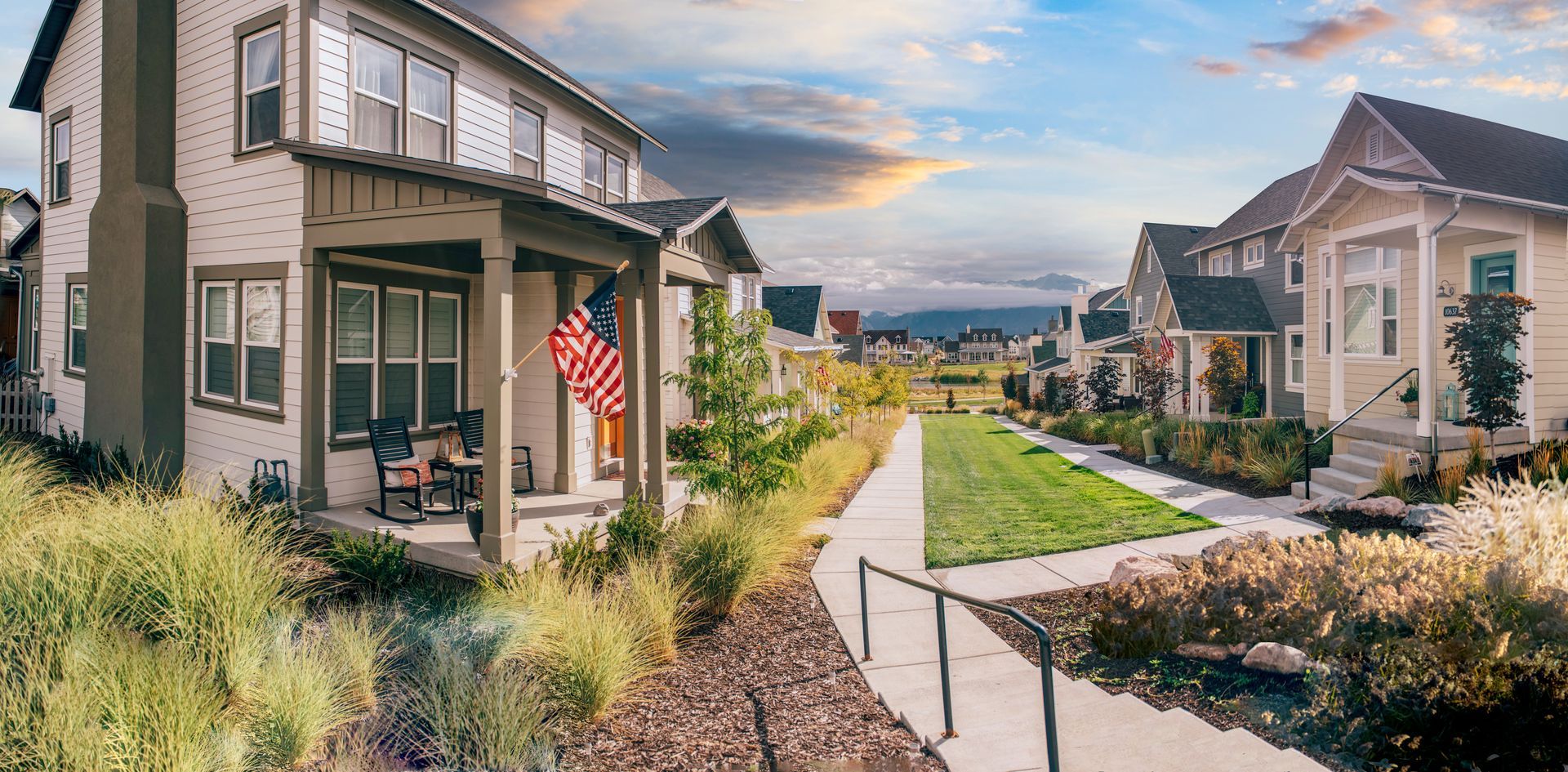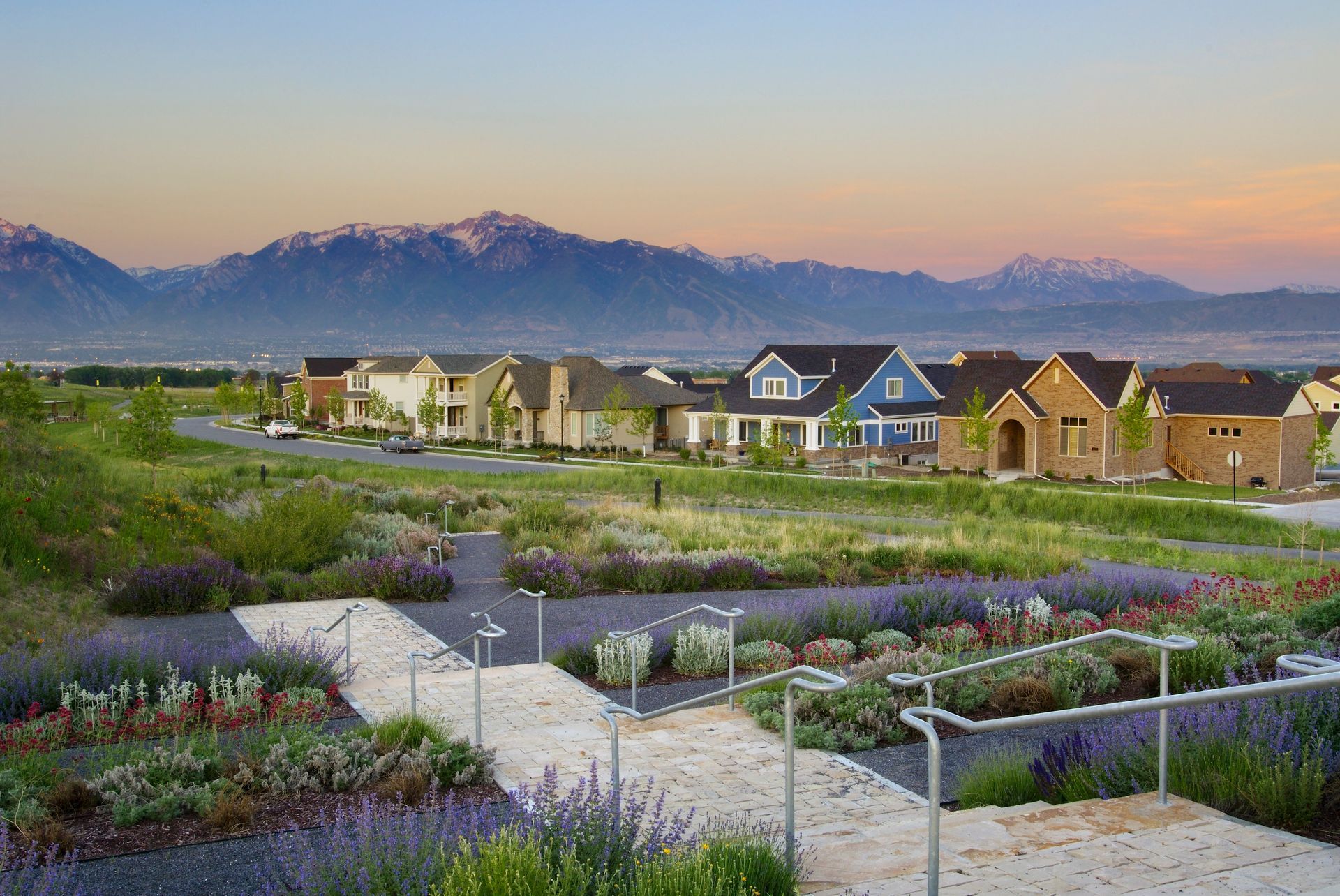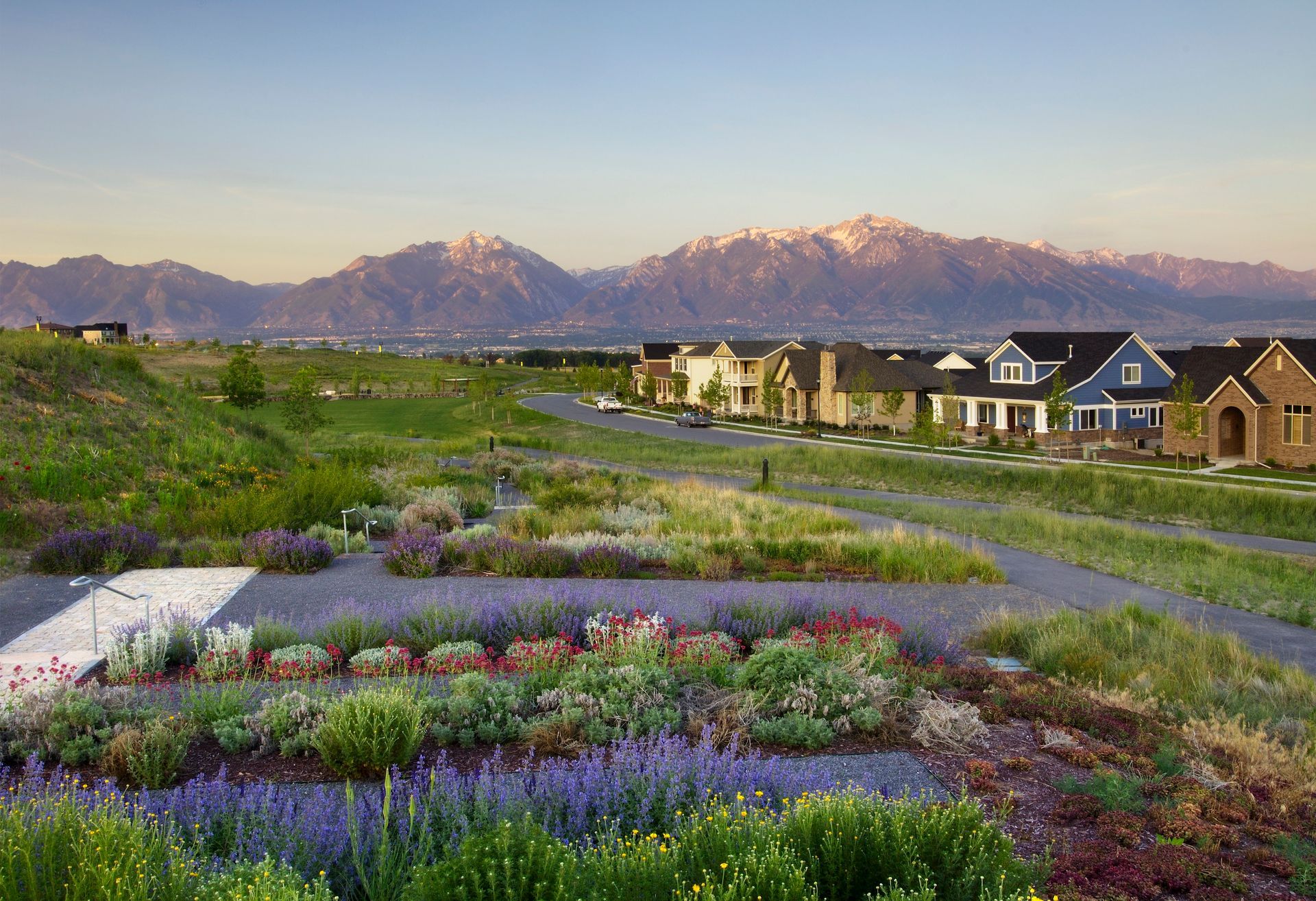Daybreak in South Jordan has been a nexus of good urbanism, as the execution of the design has followed the same trajectory outlined over 20 years ago to create a highly livable community. By Taylor Larsen

Daybreak is in South Jordan, but it feels like a different town—and it has the HOA fees to prove it.
HOA jokes aside, Daybreak is distinct within the context of Utah and urban development more broadly for what has been prioritized there since its inception in 2004. Of its 4,100-acre footprint, 20% is dedicated to trails, parks, and green spaces. Beyond recreation, the community has streets and commercial areas that look much different than its city neighbors.
Daybreak, across three ownership groups over the last 21 years, has been designed and built to maximize livability.
New Ideas for a New Community
The area known as Daybreak was originally part of over 100,000 undeveloped acres in Salt Lake and Tooele counties owned by Kennecott Land, a subsidiary of mining conglomerate Rio Tinto Group. Kennecott Land set out to create a well-planned community a few miles from its Bingham Canyon Mine. Daybreak was named for its location, where sunlight first hits the landscape as it rises above the Wasatch Mountains to the east.
Jim MacRae, Principal of Design Workshop's office in Denver, said that Kennecott Land asked his firm to review the park and open space portion of the master plan developed by Peter Calthorpe and his team at Calthorpe Associates. Instead of selling the land to the highest bidder, Design Workshop and others on the early project team noted a few key differences in the plan, like connected streets, alleyways to garages, ample green spaces, and design guidelines for builders to construct houses and front yards to make it all fit together.
Designers of the master-planned community were interested in reintroducing traditional town planning principles reemerging in a growing urban design movement called “New Urbanism”. The movement sought to get off the highway of car-centric sprawl. Instead, its followers designed cities and towns that prioritized mobility choice and human-scaled design.
Brothers Terrall and Michael Budge have been longtime design consultants for Daybreak and fans of New Urbanism. They started at Design Workshop before opening their own firm, Loci, to continue working on Daybreak. Terrall said the concepts outlined in New Urbanism "had never been done before in Utah, especially in a new community."
Stephen James is another longtime member of Daybreak’s development team, and currently serves as the Chief Visioning Officer at Larry H. Miller Real Estate, the current owner of Daybreak. James remembered the energy of the Daybreak design teams in the early 2000s, with Rio Tinto/Kennecott Land project managers, urban planners, architects, and landscape architects who built the initial vision. James recalled that Rio Tinto wanted to create a model for sustainable growth, and the young team of designers said, "Yeah! Why not?"
Land Planning for Connection
James said initial city planning conversations sought to rethink transportation.
“We wanted to find an alternative development pattern that would encourage people to leave their car at home,” said James. The transportation network still needed to connect people to amenities, services, and jobs, and be oriented in a way where people could choose to walk or bike instead of driving.
"As we began to look at cities trying to retrofit bicycle paths into their communities, they were always running along busy roads," said James. "And that's not always comfortable for cyclists."
James and other designers envisioned what it would take to get young mothers and children out on bicycles.
"We needed to create trails and an open space system parallel to, and equitable with, the street system, so that walking and cycling are actually legitimate choices that people would opt in to using,” James said.
Designers researched how to create open spaces effectively, link them together with other amenities, and encourage people to use them.
"It's like a string of pearls," James laughed. "We learned that not only do you have to create connections, but you have to create desirable, amenity-filled experiences. It has to be beautiful. It has to be designed and scaled to the human pace—three to four miles an hour—which means the architecture had to change."
Designers continued tinkering, imagining how infrastructure would relate to architecture and housing, how residents would flow out of their homes and into the community, and how design could make it as easy to walk out the front door as it is to drive out of the garage door.
"It was a laboratory for growth […] and preservation of quality of life," James recalled of those conversations with South Jordan, Kennecott Land, and the design teams. "We were asking, 'What does quality growth in this market look like?' We were testing, pushing, refreshing, trying to discover and uncover how to develop."
Design Team Coalesces
That laboratory mentality led to refining the development team’s approach to housing community form and the design of parks and open spaces.
"To [Kennecott Land's] credit, they wanted to preserve open space within their development. It was unheard of at the time," said Michael Budge, Principal at Loci. Both he and Terrall, a fellow Principal at Loci, credited the developer for pushing their team to imagine something better. "And that seeped through to us to rethink things," added Michael.
One of the first examples of rethinking came via Oquirrh Lake. Original plans, said Terrall, had the lake lined in concrete, chemically treated, and fountains spraying "like a commercial office pond."
Would it be successful? Probably. But environmentally sustainable? No chance.
After a rethink and a redesign, Oquirrh Lake became not just a 67-acre body of water, but over 130 acres of recreation space and reinvigorated wildlife habitat—a residential island with several miles of pedestrian trails, picnic areas, bridges, and a reflecting pond to go with a new home for fish like rainbow trout and largemouth bass, and birds like grebes and coots.
"It was more than something nice to paddleboard on," said MacRae of the new design, which opened to the public in 2006. "Oquirrh Lake became an ecological asset for the community."
Water remained a key topic in all discussions surrounding Daybreak's green spaces. Collaboration between ownership and Loci, as landscape architects, brought forth water-saving landscaping that required less irrigation. Those same landscapes were designed to capture stormwater to recharge aquifers instead of sending it into the South Jordan storm drains.
According to Don Tingey, Assistant City Manager for the City of South Jordan, Kennecott Land's goal of establishing a sustainable community is reflected in the master development agreement signed in 2003, which requires all stormwater to be retained within Daybreak.
"This has encouraged the developer and [South Jordan] to be innovative in their design and implementation of proposed concepts," Tingey said.
By utilizing the landscape to pre-treat the water and flush the soil of the sulfate plume from Rio Tinto's previous mining operations, James added, "Growth and development have helped to heal the land, where water stays on site and pre-treating it has created a beautiful aesthetic."
Adhering to the agreement, Terrall said, has saved the South Jordan money by reducing stormwater infrastructure and helped create a healthier community.
"Daybreak landscapes do multiple things," he said. "It's an aesthetic amenity, infrastructure, and recreation space. […] it's the biggest bang for your buck."
To his point, landscapes serve yet another function as transportation infrastructure, creating a walkable community for Daybreak residents. Tingey said that 61% of respondents to a South Jordan resident survey indicated they visited the Daybreak Trail System in the past 12 months, making it the most-traveled system in South Jordan as it takes residents and visitors to churches, schools, parks, and commercial areas across Daybreak's 4,100 acres.
Elizabeth Gray, Larry H. Miller Real Estate’s Senior Director of Marketing, said that design like this centers around the "five-minute life", where there is "something within a five-minute walk from everyone's front door that is engaging—a surprise and delight."
Work Continues Under Larry H. Miller Ownership
Under the stewardship of owners Larry H. Miller Real Estate, who purchased Daybreak in 2021, plans continue to reap the rewards from prioritizing liveability.
Today, "Daybreak is one of the most successful master planned communities, and it has been for years," said Terrall, and one he mentioned that is "replicable everywhere."
James agreed, saying many ideas behind Daybreak aren't new, but came from "memories of being free-range kids in small-town Logan," referring to himself, Michael, and Terrall. Those three, along with a host of others across 21 years of project teams, wanted the same thing—a safe place where kids could be kids, where parents could walk to work, and where grandparents could age in place—a community where people came first.
"It's about bringing people along and giving people a choice to opt in," James said of Daybreak's plans and their realization over 21 years and counting. "And people are choosing it because of its advantages."



































